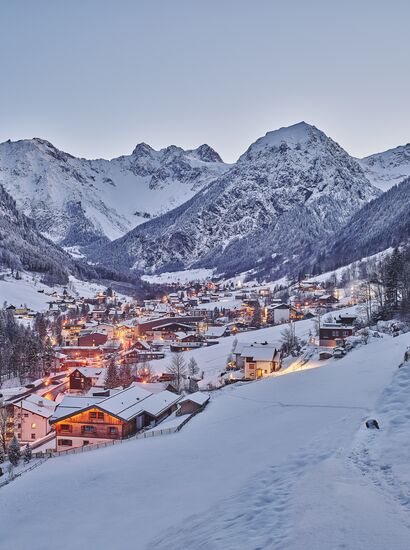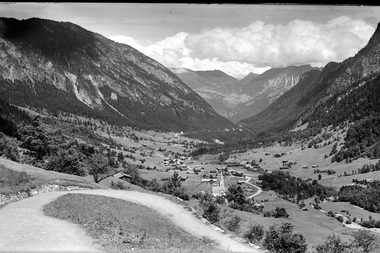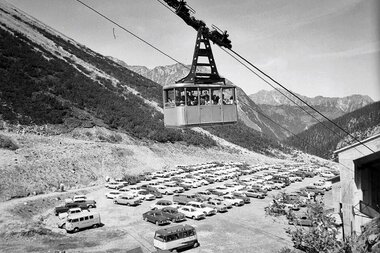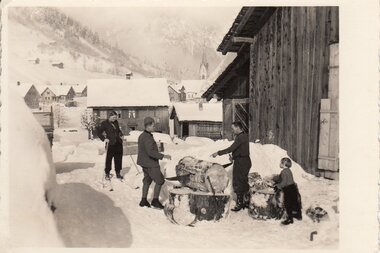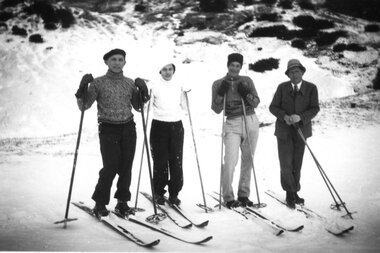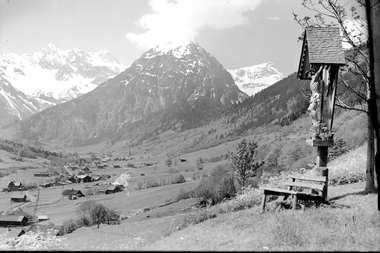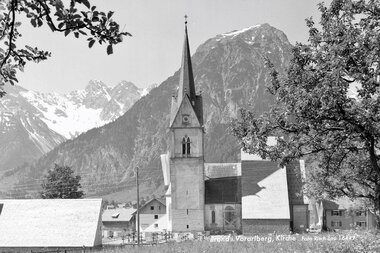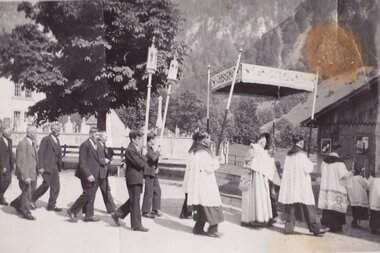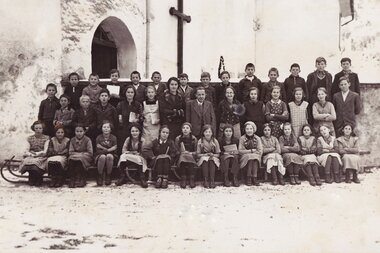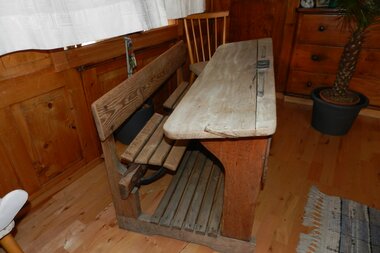Hi, Habidere!
Our language
And what language do the Brandner people speak? Guests are greeted with "Grüaß Gott" and after a few words they can tell from our dialect that they are among the Alemanni. The people from the Valais who moved to Brand brought with them not only their culture and customs but also their highly Alemannic language. This language was able to survive for a very long time due to the village's remote location. However, during the 700 years of spatial separation from the Valais, it developed independently and many characteristic Walser elements were gradually lost. If you want to know how people spoke in Brand around 100 years ago, I recommend reading the legend of the "Totenalp", written in our dialect by Prof. Dr. Nikolaus Neßler from Brand. It sounds just like the way we spoke back then.
You might assume that the Brandner dialect has adapted to the dialects of the neighboring villages. But this is not the case, as there are already noticeable differences to the neighboring village of Bürserberg, just five kilometers away. It starts with counting: ääs, zwää, says the Brandner, aas, zwaa the Bürserberger. The Brandner can also be recognized immediately by his "ä sounds", which replace the diphthong "ei" in High German, such as "häm" for heim or "Mänig" for Meinung. The Bürserberger in turn pronounces this diphthong as a pure "a", such as "ham" or "Manig".
Then there is the blunt "ä", which cannot be pronounced at all in the common written form and only the older "Pranner" pronounce it correctly, such as Säefa for soap or Säel for rope. In Bürserberg it is "Saafa" and "Saal", so there is a noticeable difference.
The fact is that our dialect has become increasingly diluted with others over the course of time. There are several reasons for this. Since the 1970s, our children have had to attend a secondary school away from home after four years of elementary school. There they adopt the language of the class majority - often out of false shame. In many cases, Brandner dialect is no longer spoken at home because many mothers and fathers are not from our village. The belief that guests don't understand us in dialect and that we should speak High German with them unfortunately also contributes to this. As a result, our beautiful Brandner dialect, which is probably unique in the Ländle, has come under pressure from tourism, higher education and the media.
In Vorarlberg, our Alemannic dialect is undergoing a generally drastic change. The expression "i bi gsi" is slowly being replaced by "i was". It makes me sad to see the "gsi" disappearing more and more, not only in the "Ländle", but also here in Brand. It's a shame for our dialect and for the "Gsiberger", as the Austrians still affectionately call us. Hopefully I won't have to see us become "Warberger" one day! In my opinion, speaking the Brandner dialect must be a matter of the heart, of self-confidence and of identity with our beautiful homeland!
Old saw
Economy
Until the advent of tourism, agriculture was the only source of income. There is evidence that there was a water wheel in the 17th century, which was used to power a saw and a mill. The facilities belonged to the municipality. In addition to barley, oats and rye, the mill mainly ground maize. However, due to the climate, this type of grain hardly thrived anymore. The grain was therefore bought "in the country" and carried on the back to Brand. Every Brandner milled the grain himself for cost reasons. Each house baked its own bread, there was no bakery. There was also no communal dairy, as the milk was processed into butter and the popular "Suura Käs" cheese in each house.
From the middle of the 19th century, a modest touch of alpinism could be felt. In the years that followed, Brandnertal quickly developed into an Eldorado for mountaineers and, from the turn of the century, a popular climatic health resort for summer visitors. The number of guest hostels on offer was continually increased and craft businesses also emerged in the village. In 1890, Franz Adam Beck and Josef Bitschi built a brickworks near the Schliefwaldtobel bridge and produced bricks, as the rise in tourism led to an increase in construction. Around 1900, Bernhard Meyer started a carpentry business. He bought his own portable saw and cut the required timber at the most suitable location. At the same time, Fidel Sugg ran a carpentry business on the Alvierbach and had full order books due to the many new buildings and conversions. In 1928, Friedolin Meyer from Brand, who had previously learned the baker's trade, opened his own bakery, which is still supplying bread to restaurants and hotels today, now in its third generation.
The construction of the "Brand-Eggen-Niggenkopf" cable car can be seen as a milestone in the development of tourism in our village. After its opening on December 26, 1951, tourism experienced an unexpected upswing and became the "number one" economic factor. Today, tourism is the biggest employer in our village. Agriculture, however, declined more and more. One farmer after another closed their barn doors and saw better earning opportunities in tourism.
Sacred Heart Chapel
The element of water
The Herz-Jesu-Kirche is located among the natural monuments that are based on the element of water. The people of Branden recognized early on that water is our greatest asset. The Glingabrunnen is one of the most impressive natural monuments in Vorarlberg. It consists of countless springs that are fed directly from the Brandner glacier via underground tributaries and allow the water to bubble out of the ground at the Glingabrunnen. The water then plunges over a steep step with mossy moraine boulders into the valley and joins the Palüdbach stream. However, this natural spectacle can only be observed when the glacier melts between mid-May and mid-October.
The Brandner Glacier, also known as the Brandner Ferner, is Austria's westernmost glacier and the only one in the Rätikon. It is only a few kilometers wide or long. The Mannheimer Hütte is located on the edge of the glacier. From there, a path leads across the glacier to the Schesaplana, the highest peak in the Rätikon. As late as the 19th century, the Fohrenburg brewery in Bludenz used to fetch blocks of ice that fell from the glacier over the so-called Gletschertolla into the valley to cool the beer. The natural outflow takes place in the block ice via the Gletscherbach and Alvierbach streams to the Ill, but also southwards at the Schafjoch via the Valserbach and Taschinasbach streams into the Landquart (Switzerland).
The Kesselfall, another natural monument in Brand, is an excursion destination with an impressive water feature. The waterfall lies in a wild and romantic rocky gorge. In this area, the Alvierbach stream tumbles through a deep gorge, roaring and foaming for around 40 meters. Two waterfalls and large whirlpools bear eloquent witness to the power of a mountain stream. Only those who visit the Kesselfall will understand how intensively erosion processes take place even in the geological present and thus shape our landscape.
Walser ensemble + parish church
Church history
The people of Valais who immigrated at the beginning of the 14th century were Catholic and very God-fearing. However, they had no place of worship for their religious needs. So for many years they had to fulfill their Sunday duty in Bürs, more than two hours away, where they got married, baptized their children and buried their dead. In deep winter conditions and avalanche danger, it is even said that the deceased were laid out at home for weeks and children could not be baptized. It is understandable that they longed for their own chapel and cemetery.
In 1410, work began on building a chapel in honor of "Our Lady". At this time, Hensli Alamann and his son Jösli were "sick, sickly and sick of their bodies".
The two lepers had no descendants and so they donated the property belonging to them "for the benefit of the whole community" to promote religious services and to make it possible for a priest to be appointed. With their dedication, they laid the foundation stone for a later parish benefice. The chapel and cemetery, which had been completed in the meantime, was consecrated in 1423 by the Auxiliary Bishop of Chur, Frater Panthaleon, in honor of the Mother of God. The south of Vorarlberg, including Brand, belonged to the diocese of Chur until 1816. After that, their shares were ceded to the diocese of Brixen.
The people of Brand had a church, but no permanent priest. In 1476, the Bishop of Chur finally approved a permanent chaplain. He was allowed to administer the holy sacraments, but was subordinate to the parish priest of Bürs. Nevertheless, the people of Branden accepted the decision with joy, especially as they were spared the long and dangerous journey to their mother church in Bürs. Delighted with their partial independence, they demolished the chapel and built a church with four altars and a baptismal font on the same site. This was consecrated in 1507 by the Auxiliary Bishop of Chur, Stephanus Tschuggli.
The position of chaplain in a remote, hard-to-reach mountain village was not in great demand. As a result, it was not always possible to find a permanent priest. During this time, the mother church in Bürs took over pastoral care. From the Brandner's point of view, however, this was very negligent. Children died without being baptized and adults without receiving the last rites. These grievances naturally led to disputes and many a trip to Chur by the people of Brand to complain to the bishop. It took until 1727 for a "high spiritual tribunal" in Chur to finally decide that Brand should become its own parish, independent of Bürs. To the delight of the people of Brand, the parish rule of Bürs, which had lasted for over 250 years, was finally over!
Franz Mäser, parish priest from 1827 to 1841, writes the following about the church in his chronicle: "The church was renovated in 1781. It is too small for the current number of souls in the parish. It has three wooden altars. The church has a main altar and two side altars, an organ, a gallery, a pulpit, a confessional, a sacristy and three small bells. All the buildings and equipment are poor. The churchyard is next to the church and has been there since before 1476".
In 1902, the Samuel Kegele family from the former Kegele inn and boarding house donated a fourth large bell in addition to the three small ones. As there was not enough space in the tower to accommodate it, it had to be rebuilt and raised by six meters. The plans were drawn up by the young primary school teacher Fidel Schallert. His father, master carpenter Josef Schallert from Bürserberg, carried out the work.
Instead of the previous gabled roof, the tower was given a pointed spire. The new bell ringing did not please the people of Branden for long, because shortly after the outbreak of the First World War in 1914, three bells had to be sacrificed for the production of war material. It was not until 1923 that the church received a new bronze bell. The large bell, weighing 2100 kg, was the war bell on which the names of the fallen of the First World War were immortalized. In April 1942, three bells again had to be delivered for war purposes. What remained was the smallest bell, the Barbara bell. It still announces the death of every human being today. In 1950, three new bells were added to the peal. The last bell consecration with six new bells took place in 1978.
As the population grew, the church could no longer accommodate all the worshippers. As early as the 1930s, plans were made to extend the church. However, the parish priest and congregation were unable to agree on the type of extension. It was not until 1960 that the parish council made the decision to rebuild and enlarge the church according to the plans of Bregenzerwald architects Leopold Kaufmann and Bernhard Haeckel. The construction work was carried out between 1961 and 1964. The tower was given back its original gabled roof instead of the pointed spire. In 2008, the last building work was carried out in the church area with the construction of the "Walserensemble". The parish church "Mariä Himmelfahrt", the listed rectory, the old schoolhouse, the Walserhus and an old cattle shed are located here. These buildings form a small center and bring the former village center back to life.
Rectory + school building
The school system
Until the second half of the 18th century, education in the imperial and royal hereditary lands of the Habsburg Monarchy was mainly reserved for the nobility and future clergy. Hereditary Lands of the Habsburg Monarchy, education was mainly reserved for the nobility and future clergy. Monastery schools were almost the only educational institutions. This changed under Empress Maria Theresa in 1774, when she introduced a school reform with a public elementary school and six years of compulsory schooling for boys and girls. At that time, there was still no school in Brand and apart from the parish priest, only a few people could read and write. It is not known when the first school building was built or who the first teacher was. Chrysogonus Sugg from Rungelin is mentioned by name for the first time. His assignment as a teacher at the Brand elementary school was approved by decree of the Bludenz district office on December 11, 1793 at the suggestion of the community.
The position of teacher in the remote and hard-to-reach mountain village of Brand was not particularly sought after. It therefore often remained vacant. In this case, the parish priest stepped in and taught arithmetic, writing and reading as well as Christian instruction. School lessons only took place in the winter months. Pastor Franz Mäser wrote in his chronicle: "There is only one school in Brand, next to the parish church. There is only one classroom. In the winter of 1833/34, 76 children attended the school. It has its own teacher, who is also the organist."
In 1869, the Reich School Act extended the school's area of activity. In addition to the previous subjects of religion, reading, writing and arithmetic, it also included geometry, natural history and geography, history, gymnastics and female handicrafts. Compulsory schooling was also increased from six to eight years. In 1884, the parish introduced a Sunday school during the winter months at the suggestion of the pastor. All schoolchildren up to the age of 18 were required to attend school. The pastor and teacher held the lessons together. When the number of pupils rose to 75 children in 1911/12, the parish committee decided to hire a second teacher and to run the school as a two-class school from then on. In 1914, at the beginning of the First World War, no second teacher could be found and half-day lessons had to be introduced. To make matters worse, principal Fidel Schallert received a call-up order in July 1916. Brand was suddenly left without a teacher! Despite the best efforts of the community leader, no replacement teacher could be found. Without further ado, 24-year-old Leo Beck stepped in as an assistant teacher and taught the pupils from first to eighth grade. Although he had no pedagogical training, he was known as a particularly bright pupil. He also had good common sense.
After the First World War, a second teacher was employed again and the school was run with two classes. In 1972/73, however, there was a drastic change. Due to organizational changes in the school system, the upper school was discontinued and pupils from the 5th grade onwards had to transfer to the Hauptschule in Bürs or the Realgymnasium in Bludenz. Despite the lower number of pupils, Brandner Volksschule remained a two-class school. What no longer exists is the school fair that was customary in earlier years. Until the early 1980s, every school day began at 7:15 a.m. with a holy mass. Attendance was compulsory for the pupils and supervision was mandatory for the respective teacher. Would that still be possible today?
Source: A LOOK AT THE WALSERGEMEINDE BRAND BY MANFRED BECK
Dipl. Ing. Manfred Beck former mayor and former member of the state parliament in 2020
Images: Picture archive Michael Beck
